Tanenbaum A. Computer Networks
Подождите немного. Документ загружается.

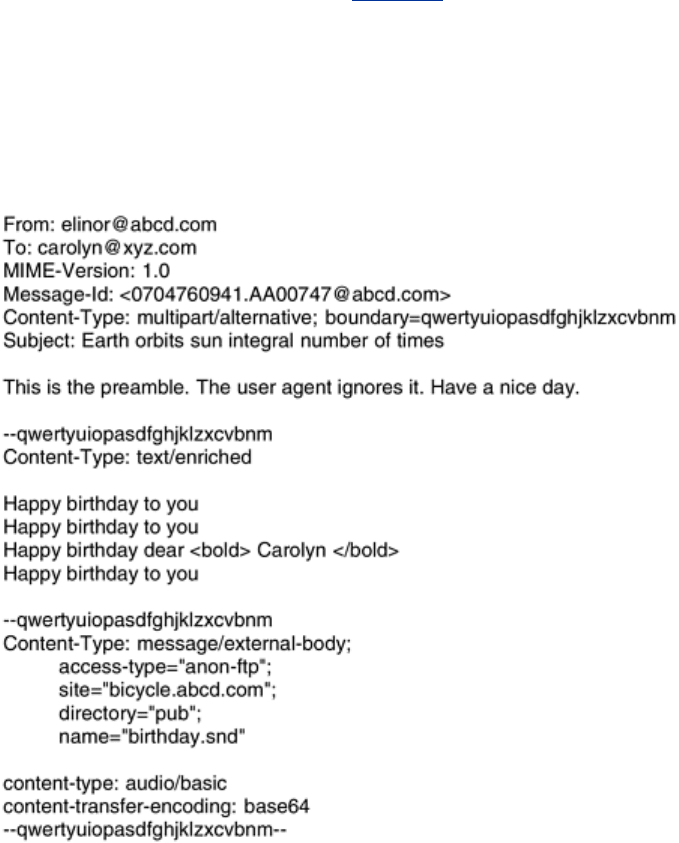
provide one or more attachments to a text message. These attachments are sent using the
multipart type.
In contrast to
multipart, the alternative subtype, allows the same message to be included
multiple times but expressed in two or more different media. For example, a message could be
sent in plain ASCII, in enriched text, and in PostScript. A properly-designed user agent getting
such a message would display it in PostScript if possible. Second choice would be enriched
text. If neither of these were possible, the flat ASCII text would be displayed. The parts should
be ordered from simplest to most complex to help recipients with pre-MIME user agents make
some sense of the message (e.g., even a pre-MIME user can read flat ASCII text).
The
alternative subtype can also be used for multiple languages. In this context, the Rosetta
Stone can be thought of as an early
multipart/alternative message.
A multimedia example is shown in
Fig. 7-13. Here a birthday greeting is transmitted both as
text and as a song. If the receiver has an audio capability, the user agent there will fetch the
sound file,
birthday.snd, and play it. If not, the lyrics are displayed on the screen in stony
silence. The parts are delimited by two hyphens followed by a (software-generated) string
specified in the
boundary parameter.
Figure 7-13. A multipart message containing enriched and audio
alternatives.
Note that the
Content-Type header occurs in three positions within this example. At the top
level, it indicates that the message has multiple parts. Within each part, it gives the type and
subtype of that part. Finally, within the body of the second part, it is required to tell the user
agent what kind of an external file it is to fetch. To indicate this slight difference in usage, we
have used lower case letters here, although all headers are case insensitive. The
content-
transfer-encoding
is similarly required for any external body that is not encoded as 7-bit
ASCII.
461

Getting back to the subtypes for multipart messages, two more possibilities exist. The parallel
subtype is used when all parts must be ''viewed'' simultaneously. For example, movies often
have an audio channel and a video channel. Movies are more effective if these two channels
are played back in parallel, instead of consecutively.
Finally, the
digest subtype is used when many messages are packed together into a composite
message. For example, some discussion groups on the Internet collect messages from
subscribers and then send them out to the group as a single
multipart/digest message.
7.2.4 Message Transfer
The message transfer system is concerned with relaying messages from the originator to the
recipient. The simplest way to do this is to establish a transport connection from the source
machine to the destination machine and then just transfer the message. After examining how
this is normally done, we will examine some situations in which this does not work and what
can be done about them.
SMTP—The Simple Mail Transfer Protocol
Within the Internet, e-mail is delivered by having the source machine establish a TCP
connection to port 25 of the destination machine. Listening to this port is an e-mail daemon
that speaks
SMTP (Simple Mail Transfer Protocol). This daemon accepts incoming
connections and copies messages from them into the appropriate mailboxes. If a message
cannot be delivered, an error report containing the first part of the undeliverable message is
returned to the sender.
SMTP is a simple ASCII protocol. After establishing the TCP connection to port 25, the sending
machine, operating as the client, waits for the receiving machine, operating as the server, to
talk first. The server starts by sending a line of text giving its identity and telling whether it is
prepared to receive mail. If it is not, the client releases the connection and tries again later.
If the server is willing to accept e-mail, the client announces whom the e-mail is coming from
and whom it is going to. If such a recipient exists at the destination, the server gives the client
the go-ahead to send the message. Then the client sends the message and the server
acknowledges it. No checksums are needed because TCP provides a reliable byte stream. If
there is more e-mail, that is now sent. When all the e-mail has been exchanged in both
directions, the connection is released. A sample dialog for sending the message of
Fig. 7-13,
including the numerical codes used by SMTP, is shown in
Fig. 7-14. The lines sent by the client
are marked
C:. Those sent by the server are marked S:.
Figure 7-14. Transferring a message from elinor@abcd.com to
carolyn@xyz.com.
462
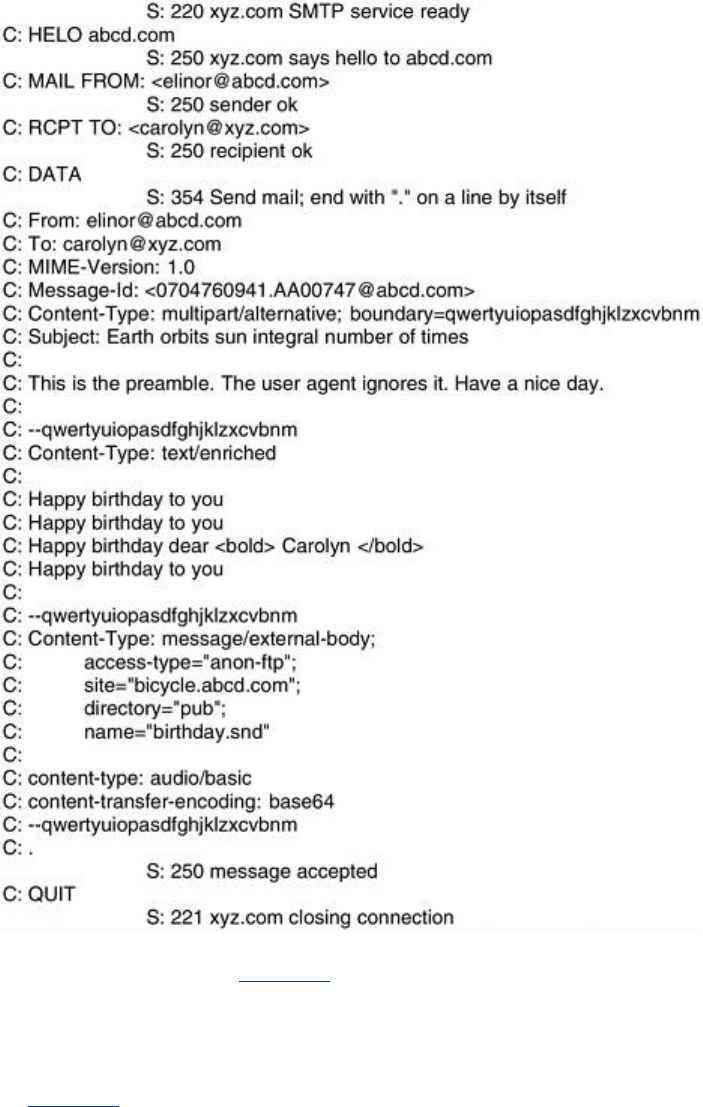
A few comments about
Fig. 7-14 may be helpful. The first command from the client is indeed
HELO. Of the various four-character abbreviations for HELLO, this one has numerous
advantages over its biggest competitor. Why all the commands had to be four characters has
been lost in the mists of time.
In
Fig. 7-14, the message is sent to only one recipient, so only one RCPT command is used.
Such commands are allowed to send a single message to multiple receivers. Each one is
individually acknowledged or rejected. Even if some recipients are rejected (because they do
not exist at the destination), the message can be sent to the other ones.
Finally, although the syntax of the four-character commands from the client is rigidly specified,
the syntax of the replies is less rigid. Only the numerical code really counts. Each
implementation can put whatever string it wants after the code.
To get a better feel for how SMTP and some of the other protocols described in this chapter
work, try them out. In all cases, first go to a machine connected to the Internet. On a UNIX
system, in a shell, type
463

telnet mail.isp.com 25
substituting the DNS name of your ISP's mail server for
mail.isp.com. On a Windows system,
click on Start, then Run, and type the command in the dialog box. This command will establish
a telnet (i.e., TCP) connection to port 25 on that machine. Port 25 is the SMTP port (see
Fig. 6-
27 for some common ports). You will probably get a response something like this:
Trying 192.30.200.66...
Connected to mail.isp.com
Escape character is '^]'.
220 mail.isp.com Smail #74 ready at Thu, 25 Sept 2002 13:26 +0200
The first three lines are from telnet telling you what it is doing. The last line is from the SMTP
server on the remote machine announcing its willingness to talk to you and accept e-mail. To
find out what commands it accepts, type
HELP
From this point on, a command sequence such as the one in Fig. 7-14 is possible, starting with
the client's
HELO command.
It is worth noting that the use of lines of ASCII text for commands is not an accident. Most
Internet protocols work this way. Using ASCII text makes the protocols easy to test and
debug. They can be tested by sending commands manually, as we saw above, and dumps of
the messages are easy to read.
Even though the SMTP protocol is completely well defined, a few problems can still arise. One
problem relates to message length. Some older implementations cannot handle messages
exceeding 64 KB. Another problem relates to timeouts. If the client and server have different
timeouts, one of them may give up while the other is still busy, unexpectedly terminating the
connection. Finally, in rare situations, infinite mailstorms can be triggered. For example, if host
1 holds mailing list
A and host 2 holds mailing list B and each list contains an entry for the
other one, then a message sent to either list could generate a never-ending amount of e-mail
traffic unless somebody checks for it.
To get around some of these problems, extended SMTP (
ESMTP) has been defined in RFC
2821. Clients wanting to use it should send an
EHLO message instead of HELO initially. If this
is rejected, then the server is a regular SMTP server, and the client should proceed in the usual
way. If the
EHLO is accepted, then new commands and parameters are allowed.
7.2.5 Final Delivery
Up until now, we have assumed that all users work on machines that are capable of sending
and receiving e-mail. As we saw, e-mail is delivered by having the sender establish a TCP
connection to the receiver and then ship the e-mail over it. This model worked fine for decades
when all ARPANET (and later Internet) hosts were, in fact, on-line all the time to accept TCP
connections.
However, with the advent of people who access the Internet by calling their ISP over a
modem, it breaks down. The problem is this: what happens when Elinor wants to send Carolyn
e-mail and Carolyn is not currently on-line? Elinor cannot establish a TCP connection to Carolyn
and thus cannot run the SMTP protocol.
One solution is to have a message transfer agent on an ISP machine accept e-mail for its
customers and store it in their mailboxes on an ISP machine. Since this agent can be on-line
all the time, e-mail can be sent to it 24 hours a day.
464
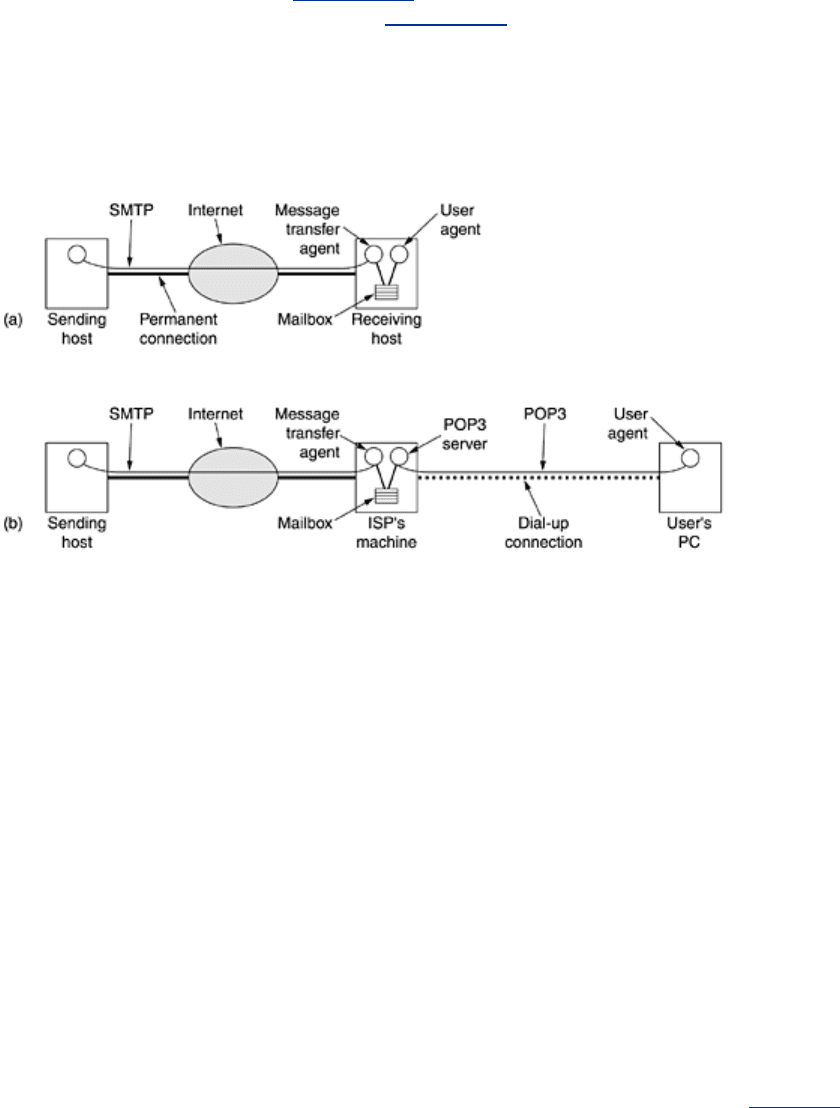
POP3
Unfortunately, this solution creates another problem: how does the user get the e-mail from
the ISP's message transfer agent? The solution to this problem is to create another protocol
that allows user transfer agents (on client PCs) to contact the message transfer agent (on the
ISP's machine) and allow e-mail to be copied from the ISP to the user. One such protocol is
POP3 (Post Office Protocol Version 3), which is described in RFC 1939.
The situation that used to hold (both sender and receiver having a permanent connection to
the Internet) is illustrated in
Fig. 7-15(a). A situation in which the sender is (currently) on-line
but the receiver is not is illustrated in
Fig. 7-15(b).
Figure 7-15. (a) Sending and reading mail when the receiver has a
permanent Internet connection and the user agent runs on the same
machine as the message transfer agent. (b) Reading e-mail when the
receiver has a dial-up connection to an ISP.
POP3 begins when the user starts the mail reader. The mail reader calls up the ISP (unless
there is already a connection) and establishes a TCP connection with the message transfer
agent at port 110. Once the connection has been established, the POP3 protocol goes through
three states in sequence:
1. Authorization.
2. Transactions.
3. Update.
The authorization state deals with having the user log in. The transaction state deals with the
user collecting the e-mails and marking them for deletion from the mailbox. The update state
actually causes the e-mails to be deleted.
This behavior can be observed by typing something like:
telnet mail.isp.com 110
where
mail.isp.com represents the DNS name of your ISP's mail server. Telnet establishes a
TCP connection to port 110, on which the POP3 server listens. Upon accepting the TCP
connection, the server sends an ASCII message announcing that it is present. Usually, it
begins with
+OK followed by a comment. An example scenario is shown in Fig. 7-16 starting
after the TCP connection has been established. As before, the lines marked
C: are from the
465
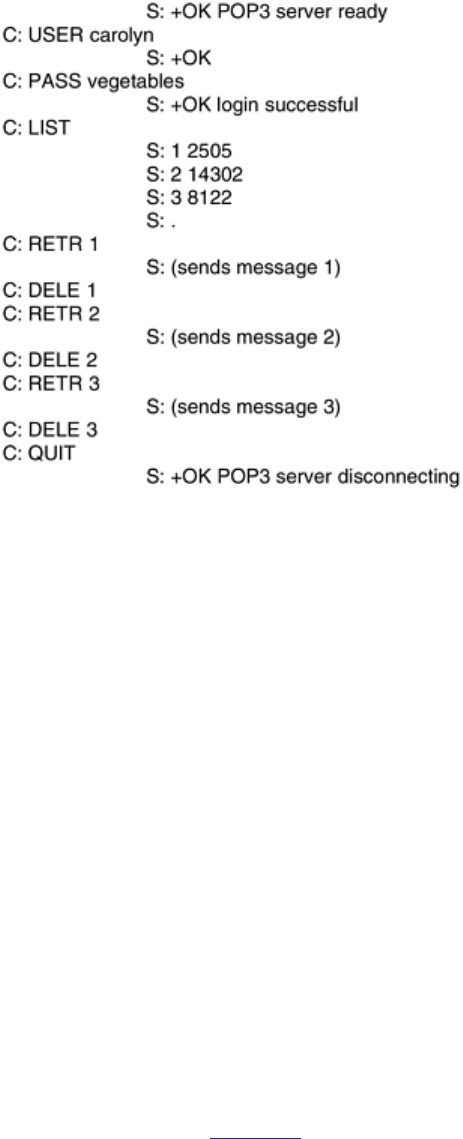
client (user) and those marked S: are from the server (message transfer agent on the ISP's
machine).
Figure 7-16. Using POP3 to fetch three messages.
During the authorization state, the client sends over its user name and then its password. After
a successful login, the client can then send over the
LIST com
mand, which causes the server to list the contents of the mailbox, one message per line,
giving the length of that message. The list is terminated by a period.
Then the client can retrieve messages using the
RETR command and mark them for deletion
with
DELE. When all messages have been retrieved (and possibly marked for deletion), the
client gives the
QUIT command to terminate the transaction state and enter the update state.
When the server has deleted all the messages, it sends a reply and breaks the TCP connection.
While it is true that the POP3 protocol supports the ability to download a specific message or
set of messages and leave them on the server, most e-mail programs just download
everything and empty the mailbox. This behavior means that in practice, the only copy is on
the user's hard disk. If that crashes, all e-mail may be lost permanently.
Let us now briefly summarize how e-mail works for ISP customers. Elinor creates a message
for Carolyn using some e-mail program (i.e., user agent) and clicks on an icon to send it. The
e-mail program hands the message over to the message transfer agent on Elinor's host. The
message transfer agent sees that it is directed to
carolyn@xyz.com so it uses DNS to look up
the
MX record for xyz.com (where xyz.com is Carolyn's ISP). This query returns the DNS name
of
xyz.com's mail server. The message transfer agent now looks up the IP address of this
machine using DNS again, for example, using
gethostbyname. It then establishes a TCP
connection to the SMTP server on port 25 of this machine. Using an SMTP command sequence
analogous to that of
Fig. 7-14, it transfers the message to Carolyn's mailbox and breaks the
TCP connection.
In due course of time, Carolyn boots up her PC, connects to her ISP, and starts her e-mail
program. The e-mail program establishes a TCP connection to the POP3 server at port 110 of
the ISP's mail server machine. The DNS name or IP address of this machine is typically
configured when the e-mail program is installed or the subscription to the ISP is made. After
466

the TCP connection has been established, Carolyn's e-mail program runs the POP3 protocol to
fetch the contents of the mailbox to her hard disk using commands similar to those of
Fig. 7-
16. Once all the e-mail has been transferred, the TCP connection is released. In fact, the
connection to the ISP can also be broken now, since all the e-mail is on Carolyn's hard disk. Of
course, to send a reply, the connection to the ISP will be needed again, so it is not generally
broken right after fetching the e-mail.
IMAP
For a user with one e-mail account at one ISP that is always accessed from one PC, POP3
works fine and is widely used due to its simplicity and robustness. However, it is a computer-
industry truism that as soon as something works well, somebody will start demanding more
features (and getting more bugs). That happened with e-mail, too. For example, many people
have a single e-mail account at work or school and want to access it from work, from their
home PC, from their laptop when on business trips, and from cybercafes when on so-called
vacation. While POP3 allows this, since it normally downloads all stored messages at each
contact, the result is that the user's e-mail quickly gets spread over multiple machines, more
or less at random, some of them not even the user's.
This disadvantage gave rise to an alternative final delivery protocol,
IMAP (Internet
Message Access Protocol
), which is defined in RFC 2060. Unlike POP3, which basically
assumes that the user will clear out the mailbox on every contact and work off-line after that,
IMAP assumes that all the e-mail will remain on the server indefinitely in multiple mailboxes.
IMAP provides extensive mechanisms for reading messages or even parts of messages, a
feature useful when using a slow modem to read the text part of a multipart message with
large audio and video attachments. Since the working assumption is that messages will not be
transferred to the user's computer for permanent storage, IMAP provides mechanisms for
creating, destroying, and manipulating multiple mailboxes on the server. In this way a user
can maintain a mailbox for each correspondent and move messages there from the inbox after
they have been read.
IMAP has many features, such as the ability to address mail not by arrival number as is done
in
Fig. 7-8, but by using attributes (e.g., give me the first message from Bobbie). Unlike POP3,
IMAP can also accept outgoing e-mail for shipment to the destination as well as deliver
incoming e-mail.
The general style of the IMAP protocol is similar to that of POP3 as shown in
Fig. 7-16, except
that are there dozens of commands. The IMAP server listens to port 143. A comparison of
POP3 and IMAP is given in
Fig. 7-17. It should be noted, however, that not every ISP supports
both protocols and not every e-mail program supports both protocols. Thus, when choosing an
e-mail program, it is important to find out which protocol(s) it supports and make sure the ISP
supports at least one of them.
Figure 7-17. A comparison of POP3 and IMAP.
467
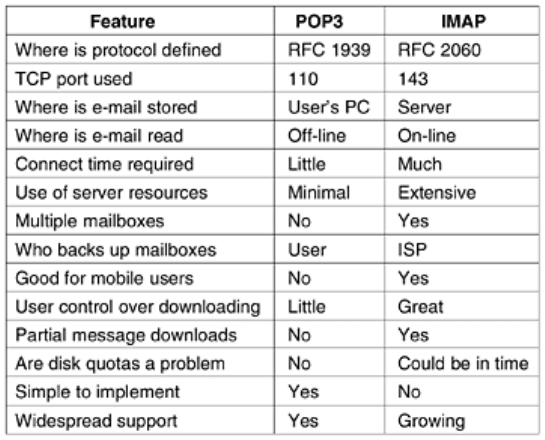
Delivery Features
Independently of whether POP3 or IMAP is used, many systems provide hooks for additional
processing of incoming e-mail. An especially valuable feature for many e-mail users is the
ability to set up
filters. These are rules that are checked when e-mail comes in or when the
user agent is started. Each rule specifies a condition and an action. For example, a rule could
say that any message received from the boss goes to mailbox number 1, any message from a
select group of friends goes to mailbox number 2, and any message containing certain
objectionable words in the Subject line is discarded without comment.
Some ISPs provide a filter that automatically categorizes incoming e-mail as either important
or spam (junk e-mail) and stores each message in the corresponding mailbox. Such filters
typically work by first checking to see if the source is a known spammer. Then they usually
examine the subject line. If hundreds of users have just received a message with the same
subject line, it is probably spam. Other techniques are also used for spam detection.
Another delivery feature often provided is the ability to (temporarily) forward incoming e-mail
to a different address. This address can even be a computer operated by a commercial paging
service, which then pages the user by radio or satellite, displaying the
Subject: line on his
pager.
Still another common feature of final delivery is the ability to install a
vacation daemon. This
is a program that examines each incoming message and sends the sender an insipid reply such
as
Hi. I'm on vacation. I'll be back on the 24th of August. Have a nice summer.
Such replies can also specify how to handle urgent matters in the interim, other people to
contact for specific problems, etc. Most vacation daemons keep track of whom they have sent
canned replies to and refrain from sending the same person a second reply. The good ones
also check to see if the incoming message was sent to a mailing list, and if so, do not send a
canned reply at all. (People who send messages to large mailing lists during the summer
probably do not want to get hundreds of replies detailing everyone's vacation plans.)
The author once ran into an extreme form of delivery processing when he sent an e-mail
message to a person who claims to get 600 messages a day. His identity will not be disclosed
here, lest half the readers of this book also send him e-mail. Let us call him John.
468

John has installed an e-mail robot that checks every incoming message to see if it is from a
new correspondent. If so, it sends back a canned reply explaining that John can no longer
personally read all his e-mail. Instead, he has produced a personal FAQ (Frequently Asked
Questions) document that answers many questions he is commonly asked. Normally,
newsgroups have FAQs, not people.
John's FAQ gives his address, fax, and telephone numbers and tells how to contact his
company. It explains how to get him as a speaker and describes where to get his papers and
other documents. It also provides pointers to software he has written, a conference he is
running, a standard he is the editor of, and so on. Perhaps this approach is necessary, but
maybe a personal FAQ is the ultimate status symbol.
Webmail
One final topic worth mentioning is Webmail. Some Web sites, for example, Hotmail and
Yahoo, provide e-mail service to anyone who wants it. They work as follows. They have normal
message transfer agents listening to port 25 for incoming SMTP connections. To contact, say,
Hotmail, you have to acquire their DNS
MX record, for example, by typing
host –a –v hotmail.com
on a UNIX system. Suppose that the mail server is called
mx10.hotmail.com, then by typing
telnet mx10.hotmail.com 25
you can establish a TCP connection over which SMTP commands can be sent in the usual way.
So far, nothing unusual, except that these big servers are often busy, so it may take several
attempts to get a TCP connection accepted.
The interesting part is how e-mail is delivered. Basically, when the user goes to the e-mail Web
page, a form is presented in which the user is asked for a login name and password. When the user
clicks on Sign In, the login name and password are sent to the server, which then validates them. If
the login is successful, the server finds the user's mailbox and builds a listing similar to that of
Fig.
7-8, only formatted as a Web page in HTML. The Web page is then sent to the browser for display.
Many of the items on the page are clickable, so messages can be read, deleted, and so on.
7.3 The World Wide Web
The World Wide Web is an architectural framework for accessing linked documents spread out
over millions of machines all over the Internet. In 10 years, it went from being a way to
distribute high-energy physics data to the application that millions of people think of as being
''The Internet.'' Its enormous popularity stems from the fact that it has a colorful graphical
interface that is easy for beginners to use, and it provides an enormous wealth of information
on almost every conceivable subject, from aardvarks to Zulus.
The Web (also known as
WWW) began in 1989 at CERN, the European center for nuclear
research. CERN has several accelerators at which large teams of scientists from the
participating European countries carry out research in particle physics. These teams often have
members from half a dozen or more countries. Most experiments are highly complex and
require years of advance planning and equipment construction. The Web grew out of the need
to have these large teams of internationally dispersed researchers collaborate using a
constantly changing collection of reports, blueprints, drawings, photos, and other documents.
469

The initial proposal for a web of linked documents came from CERN physicist Tim Berners-Lee
in March 1989. The first (text-based) prototype was operational 18 months later. In December
1991, a public demonstration was given at the Hypertext '91 conference in San Antonio,
Texas.
This demonstration and its attendant publicity caught the attention of other researchers, which
led Marc Andreessen at the University of Illinois to start developing the first graphical browser,
Mosaic. It was released in February 1993. Mosaic was so popular that a year later, Andreessen
left to form a company, Netscape Communications Corp., whose goal was to develop clients,
servers, and other Web software. When Netscape went public in 1995, investors, apparently
thinking this was the next Microsoft, paid $1.5 billion for the stock. This record was all the
more surprising because the company had only one product, was operating deeply in the red,
and had announced in its prospectus that it did not expect to make a profit for the foreseeable
future. For the next three years, Netscape Navigator and Microsoft's Internet Explorer engaged
in a ''browser war,'' each one trying frantically to add more features (and thus more bugs)
than the other one. In 1998, America Online bought Netscape Communications Corp. for $4.2
billion, thus ending Netscape's brief life as an independent company.
In 1994, CERN and M.I.T. signed an agreement setting up the
World Wide Web Consortium
(sometimes abbreviated as
W3C), an organization devoted to further developing the Web,
standardizing protocols, and encouraging interoperability between sites. Berners-Lee became
the director. Since then, several hundred universities and companies have joined the
consortium. Although there are now more books about the Web than you can shake a stick at,
the best place to get up-to-date information about the Web is (naturally) on the Web itself.
The consortium's home page is at
www.w3.org. Interested readers are referred there for links
to pages covering all of the consortium's numerous documents and activities.
7.3.1 Architectural Overview
From the users' point of view, the Web consists of a vast, worldwide collection of documents or
Web pages, often just called pages for short. Each page may contain links to other pages
anywhere in the world. Users can follow a link by clicking on it, which then takes them to the
page pointed to. This process can be repeated indefinitely. The idea of having one page point
to another, now called
hypertext, was invented by a visionary M.I.T. professor of electrical
engineering, Vannevar Bush, in 1945, long before the Internet was invented.
Pages are viewed with a program called a
browser, of which Internet Explorer and Netscape
Navigator are two popular ones. The browser fetches the page requested, interprets the text
and formatting commands on it, and displays the page, properly formatted, on the screen. An
example is given in
Fig. 7-18(a). Like many Web pages, this one starts with a title, contains
some information, and ends with the e-mail address of the page's maintainer. Strings of text
that are links to other pages, called
hyperlinks, are often highlighted, by underlining,
displaying them in a special color, or both. To follow a link, the user places the mouse cursor
on the highlighted area, which causes the cursor to change, and clicks on it. Although
nongraphical browsers, such as Lynx, exist, they are not as popular as graphical browsers, so
we will concentrate on the latter. Voice-based browsers are also being developed.
Figure 7-18. (a) A Web page. (b) The page reached by clicking on
Department of Animal Psychology.
470
